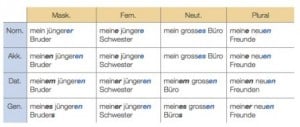
Declining adjectives is one of the most challenging parts of German. Most students taking German courses or private lessons with us struggle with that aspect of the language, even intermediate and advanced learners.
Adjectival declension is dependent on the article that precedes the adjective. There are three ways of declining adjectives: with a definite article, with an indefinite article or without an article. Bearing in mind that there are 4 cases in German, 3 genders and one plural, there are 48 ways of declining adjectives. It’s not easy for any German language student to get their head around that.
Here is an easy way to learn: 1. If no article precedes the adjective, then the adjective gets the ending of the article that would have preceded it. 2. If there is an article and it is not in its original form, then the adjective always gets an -en ending. 3. If the noun is plural and an article precedes the adjective, the ending is always -en. 4. If the article does not indicate the gender of the noun, then the adjective indicates the gender -es ending for neuter nouns and -er for masculine nouns. 5. If the article does indicate the gender of the noun, then the ending is always -e. It is as simple as that, provided you know the gender of nouns and the use of cases.

One thought on “German Adjective Declension”